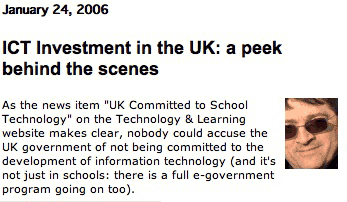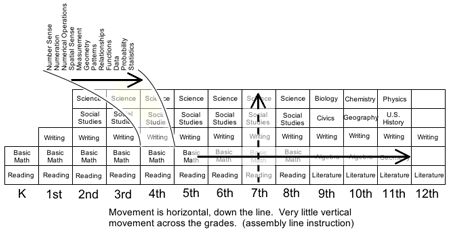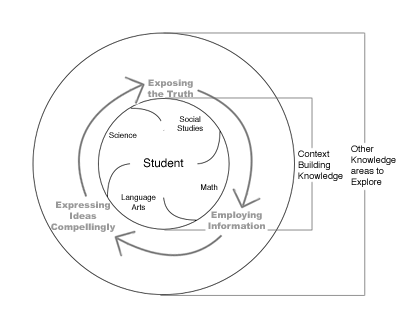[OK, so I wrote this one at the end of a very long day. It was fun to write and I'm including it here.]
Here’s another example of blogging as conversation. Terry Freedman wrote an enlightening blog yesterday morning for Technology & Learning about the state of education and ICT in the U.K. It was enlightening and grounding for me, because I frequently go on about how much more England is investing in ed tech than we here in the U.S. Freedman points out, very effectively, that it isn’t just the technology.
I responded to Terry’s post by quoting several elements of his argument and commenting on them in a 2¢ Worth blog later in the morning. Soon afterward, I discovered a comment from Ewan McIntosh — of Scotland — drawing into focus the need for staff development.
What is this? Where are we going with this conversation, or more to the point, this ability to converse regardless of geography. What are the basic skills of the great global discussion?
McIntosh points out the need for staff development as he says…
It’s not that we need to spend less in the UK on technology in education (here, inferring hardware and software) we need to spend more on training for teachers. This means training in how to turn things on and vitally training in HOW to TEACH with this technology. I always bang on about “It’s not about the tech, it’s about the teachâ€Â. Where people have the technology already they complain about not knowing how it works technically, and where people could probably envisage teaching with the tech they do not own it in their classrooms. So, more spending but on the right things. 30% hardware, 30% software, 30% training and 10% contingency.
I agree that it’s with the teacher, and the teacher has to be trained. But when I see the truly inspired applications of technology in the classroom, those unique twists of a tool that spark learning out of a void, I believe that it happens less from training and more from the wizardry of a creative and charismatic teacher. There are spells that can be cast with technology to create powerful learning experiences for students, but a teacher can’t be trained to be a wizard. You must want to become a wizard in order to learn how, and most teachers don’t even believe in them.
You’re probably wondering where I’m going with this. I got kinda carried away with the wizarding thing. My point is that the magic is not our avenue into every classroom. It’s the basics. But I’m not talking about, how you turn it on or how you sort a spreadsheet column. I’m talking about the basics of literacy. How do you access (read), process (arithmetic), and communicate (write) in a world where information is increasingly networked, digital, and overwhelming.
Now, I’ve talked all of this before. But imagine a teacher who has become a skilled researcher of the global electronic library, and has embraced the idea that information must be investigated and judged as a part of reading it. Imagine a teacher who can take page after page of tabular data from a scientific web site and turn that incomprehensible arrangement of numbers into a map that tells a story about the behavior of our planet. Imagine a teacher who begins to collect a library of content — text, images, video clips, audio files — and starts to assemble them into multimedia presentations that compellingly teach complex concepts. Imagine teachers who become literate within today’s information environment and uses these compelling new skills to craft engaging new learning experiences. What and how might students start to learn in that kind of classroom.
It’s about literacy. Magic come from new ways of thinking.

 I’d said earlier that I’m home all week, but now that I actually look at my calendar (not an everyday concern for me), I see that I’ll be flying down to Tucson on Friday for Arizona’s second installment of their annual educational technology conference series. Organized by their ISTE affiliate,
I’d said earlier that I’m home all week, but now that I actually look at my calendar (not an everyday concern for me), I see that I’ll be flying down to Tucson on Friday for Arizona’s second installment of their annual educational technology conference series. Organized by their ISTE affiliate, 




 My friend, Chris Lehmann, asked me to come up to Philadelphia today and meet with him and several other people he was bringing together to talk about his new high school, the Science Leadership Academy, to open in September. I’ve known Chris for a number of years through the WWWEDU mailing list, and my several visits to his former employer, The Beacon School, in New York City.
My friend, Chris Lehmann, asked me to come up to Philadelphia today and meet with him and several other people he was bringing together to talk about his new high school, the Science Leadership Academy, to open in September. I’ve known Chris for a number of years through the WWWEDU mailing list, and my several visits to his former employer, The Beacon School, in New York City.